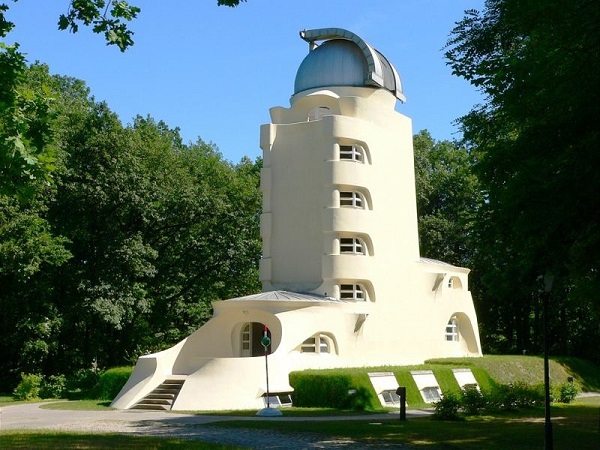Expressionist architecture
Expressionism emerged in Northern Europe in the early 20th century in poetry and painting, where it attempted to distort reality to express subjective, emotional experience. It quickly spread through all of the arts and architecture, pioneered by a group of architects from Germany, Austria and Denmark.
Expressionist architects used materials such as brick, concrete and glass to create novel sculptural forms and massing, sometimes distorted and fragmented to express an emotional perspective. Very often, expressionism involved a rejection of historical styles, symmetrical forms, and traditional designs, and instead embraced abstraction (based on structures not found or seen in the real world). This tended to result in unusual building forms using innovative construction techniques that stood out from their surroundings.
While the individualistic and informal approach to expressionist architecture makes it more difficult to define as a precise style, there are some recurring characteristics, including:
- Expressing emotion through distorted forms.
- Emphasis of symbolic or stylistic expression over realism.
- An attempt to achieve new and original designs.
- Natural themes such as mountains, lightning, rock formations, caves, and so on.
- Influence of Moorish, Egyptian, Indian and other eastern architectural styles.
- The romantic appreciation of architecture as an art form.
One of the landmark buildings of the expressionist form is the Einstein Tower by Erich Mendelsohn (see top image).
[edit] Related articles on Designing Buildings Wiki
Featured articles and news
CIOB and CORBON combine forces
To elevate professional standards in Nigeria’s construction industry.
Amendment to the GB Energy Bill welcomed by ECA
Move prevents nationally-owned energy company from investing in solar panels produced by modern slavery.
Gregor Harvie argues that AI is state-sanctioned theft of IP.
Heat pumps, vehicle chargers and heating appliances must be sold with smart functionality.
Experimental AI housing target help for councils
Experimental AI could help councils meet housing targets by digitising records.
New-style degrees set for reformed ARB accreditation
Following the ARB Tomorrow's Architects competency outcomes for Architects.
BSRIA Occupant Wellbeing survey BOW
Occupant satisfaction and wellbeing tool inc. physical environment, indoor facilities, functionality and accessibility.
Preserving, waterproofing and decorating buildings.
Many resources for visitors aswell as new features for members.
Using technology to empower communities
The Community data platform; capturing the DNA of a place and fostering participation, for better design.
Heat pump and wind turbine sound calculations for PDRs
MCS publish updated sound calculation standards for permitted development installations.
Homes England creates largest housing-led site in the North
Successful, 34 hectare land acquisition with the residential allocation now completed.
Scottish apprenticeship training proposals
General support although better accountability and transparency is sought.
The history of building regulations
A story of belated action in response to crisis.
Moisture, fire safety and emerging trends in living walls
How wet is your wall?
Current policy explained and newly published consultation by the UK and Welsh Governments.
British architecture 1919–39. Book review.
Conservation of listed prefabs in Moseley.
Energy industry calls for urgent reform.


























